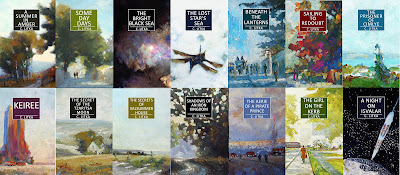C. Litka's Blog, page 27
November 11, 2023
The Saturday Morning Post (No. 21)

A new week, a new saga. This time, one you' al know.
My reviewer criteria. I like light, entertaining novels. I like smaller scale stories rather than epics. I like character focused novels featuring pleasant characters, with a minimum number of unpleasant ones. I greatly value clever and witty writing. I like first person, or close third person narratives. I dislike a lot of "head jumping" between POVs and flashbacks. I want a story, not a puzzle. While I am not opposed to violence, I dislike gore for the sake of gore. I find long and elaborate fight, action, and battle sequences tedious. Plot holes and things that happen for the convenience of the author annoy me. And I fear I'm a born critic in that I don't mind pointing out what I don't like in a story. However, I lay no claim to be the final arbitrator of style and taste, you need to decide for yourself what you like or dislike in a book.
Your opinions are always welcome. Comment below.
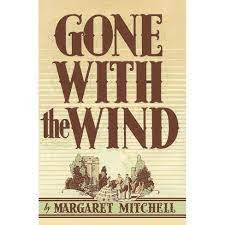
Gone With the Wind by Margaret Mitchell A-/B+
I suspect that all Americans of a certain age is familiar with the story of Gone With the Wind either from reading the book (often many times) or via the famous movie. I had neither read the book nor seen the movie before starting this saga, though I was familiar with a vague outline of the story, like most Americans of my generation. For readers not familiar with the story, for whatever reason, I'll simply say that it is a long novel first published in 1936, and has long been considered on of the great American novels. It tells the story of Scarlet O'Hara, the cold, proud, driven, and very ruthless daughter of a wealthy Plantation owner in the American South during the years from just prior to the American Civil War to the aftermath of that war known as the Reconstruction era.
Born in 1900, and growing up in Atlanta Georgia, Margaret Mitchell was a writer from an early age, writing stories and novels as a teenager. For Gone with the Wind, she was able to draw on the experiences of people who actually lived through the Civil War and the Reconstruction era that followed the war to create a story rich in the details of that time and to create a novel which reflected the life, and the attitudes of the people who endured the war and its aftermath in the Georgia countryside and the city of Atlanta, a city that was sieged, captured, and eventually burned by General Sherman's army late in the war. Mitchel wrote about those time with a wonderful mix of clear headedness and sentimentality. For that reason, the book is both loved and hated.
Once again I find myself reading and reviewing a book a book that approaches race relations from an earlier historical period. I believe that the time frame and the author must be considered when judging a book. My approach is to take these books a historical records of the time and attitude of the period, and judge the story and writing independently of those considerations.
So let's get those considerations out of the way. First, the book is written from the view point of wealthy, pre-Civil War Southern, slave owning aristocrats. If it had been written from the viewpoint of a small Southern farmer "crackers" or those below them on the social scale, "white trash," this pre-Civil War South would probably look mighty different, far less idyllic and elegant. And while Mitchell is very clear headed about the arrogance, shortcomings, and foolishness of this wealthy class, there is a strong whiff of the "romance" of the "Lost Cause" in their portrayal. Second, slavery is completely whitewashed. None of the ugly sides of slavery is ever shown, and in her very unflattering portrayal of freed slaves, she seems to be saying that the blacks were better off slaves. That said, the main black characters are treated sypathicly, as valued people. Third, she recounts the hardships of Reconstruction to a far greater extent than a story about Scarlett O'Hara would justify. This extended description of the hardships suffered in Georgia resulted in the story rather dragging in the last 1/3 of the story, at least for me. Plus as a Yankee, it invoked no sympathy in my heart. If you start a war, you better damn well win it. And if you don't win it, you must expect to pay the price of defeat, no matter how exacting that price might be, especially for a war that cost the lives of over 600,000 people, not to mention all the life-long scared survivors. And lastly, there is the now objectionable language of the time (both when written and the historical period) that is used when referring to blacks. Any modern reader needs to consider these built-in biases, when choosing whether to to read this book or not.
As for the story itself. It is quite wonderfully written, though perhaps a bit overly long, the pace sagging a bit in Parts 4 & 5, due, as I mentioned, to the overly long account of Reconstruction, as well as less exciting things happening in the later half of the story. Unlike the last saga I read, Mitchell takes you back to the old South in such a wealth of images and details that you will feel that you lived there, sometime in the half-forgotten past. You live those years through thick and thin along with Scarlett. Her writing is very fluent, not only on a sentence level, but in the way she tells the story. You sort of glide through the books shifting from long descriptive passages of places, times, people, seamlessly shifting to Scarlett thoughts, hates, fears, and most of all, her determination to succeed - at any price. Conversations are often more speeches than conversations, but are written so engagingly that they seem quite natural. The speech of all the black people in the story are written in dialect, i.e. misspelled words, take that for what you will, and except for short passages, I did not try to translate them. There is a lot of "telling" in the way this novel is written, but by and large I didn't find it a burden, at least until I neared the end...
I debated what score to give Gone With the Wind; a B+ or an A- and settled on giving it both. While I enjoyed the book a lot, I had my reservations, as stated above. I opted for A- score on the strength of how detailed, atmospheric, and just how sweeping the story Mitchell crafted was, but on a more personal enjoyment level, I did take a a few points off for a score of B+.
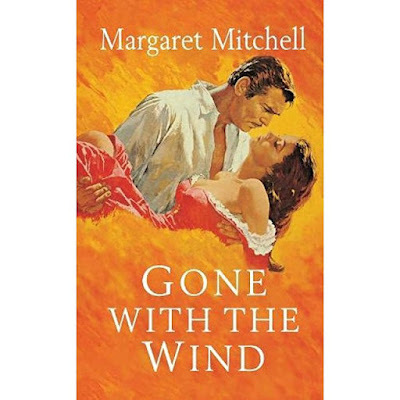
We will be reviewing two fantasy books next week, both the first of a series. After all, tomorrow's another day.
November 8, 2023
The 8 1/2 Years in Publishing Report
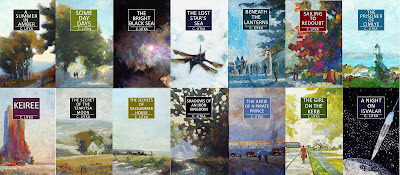
It is time once again for the semi-annual report of my publishing venture. As an author/publisher I wear two hats. As an author, I consider myself an amateur, which is to say that I write for the joy of creating. I don't need to be paid for this effort, it's its own reward. However, I take a more business-like approach in my role as a publisher.
As a publisher, my "mission statement" would read something like this; Cealanda Press's goal is to sell as many C Litka books as possible, as efficiently as possible, without loosing money in doing so. Since C Litka books are not mainstream Amazon ebooks, the likelihood of making enough money to make a financial difference in my life is nil. Thus, making money is not a priority in my publishing business. That said, not losing money is a priority, even if it could be justified as "spending" money on my "hobby." My business model is designed to meet these criteria.
With the exception of beta reading by outside volunteers, the production of my ebooks, paper books, and audiobooks is done inhouse, and as such, it involves only a minimum amount of expenditures, namely author copies of my paper books for my beta readers and postage to send it to them. This minor expense is covered by my non-free sales on Amazon. In order to achieve the widest possible sales, with the greatest efficiency, which is to say, with the least amount of effort on my part, I price my books at my cost and let their low price do all my promotional work.
In the chart below, you can see how my publishing business is doing. The first two columns compare my sales for the first half of this fiscal year year, May thru October 2023-24 to the same period last year, the last column reports total sales of each of my books to date.
I sell my ebooks for free via Smashwords, whose sales totals includes sales from Apple. Sales on Barnes & Noble (via Smashwords) is a rounding error, that I just add to the total number of books sold to the sales total. Kobo (also via Smashwords) does not report free book sales, so they are not included in these totals. I also sell ebooks and paper books via Amazon. Most, but not all, of my ebooks on Amazon.com are free, most, but not all of my ebooks are full price on Amazon stores outside of the U.S. Those sales, and the odd paper book sold account for all my revenue. In addition, I sell ebooks and audiobooks via the Google Play Store, both are sold for free. My books also are available from several other non-U.S. bookstores and libraries via Draft2Digital.
For reference, my last report, my full 8th Year report can be found here.
The Sales Chart of the first half 2022-2023 vs 2023-2024
Book Title / Release Date
1H 2022 Sales
1 H 2023
Sales
Total Sales To date ebook & audiobooks total sales
A Summer in Amber
23 April 2015
244
244 Audio
289
231 Audio
Total 9,683
Some Day Days
9 July 2015
221
331 Audio
321
201 Audio
Total 6,199
The Bright Black Sea
17 Sept 2015
925
520 Audio
397
306 Audio
Total 17,753
Castaways of the Lost Star
4 Aug 2016
Withdrawn
Withdrawn
Total 2,176
The Lost Star’s Sea
13 July 2017
423
433 Audio
371
306 Audio
Total 10,156
Beneath the Lanterns
13 Sept 2018
299
377Audio
296
215 Audio
Total 5,160
Sailing to Redoubt
15 March 2019
344
299 Audio
304
196 Audio
Total 4,858
Prisoner of Cimlye
2 April 2020
310
359 Audio
286
230 Audio
Total 3,380
Lines in the Lawn
8 June 2020
17
24
Total 169
Keiree
18 Sept 2020
331
349 Audio
339
234 Audio
Total 2,987
The Secret of the Tzaritsa Moon
11 Nov 2020
428
255 Audio
357
214 Audio
Total 4,143
The Secrets of Valsummer House
18 March 2021
290
382 Audio
265
251 Audio
Total 3,225
Shadows of an Iron Kingdom
15 July 2021
409
989 Audio
351
301 Audio
Total 3,933
A Night on Isvalar
15 July 2021
(Amazon only @.$.99 & Kindle Unlimited)
9 Star Nebula. Mystery Omnibus ($.99)
Lost Star Omnibus ($.99)
19
6
8
2
Total 46
Total 8
Total 2
The Aerie of a Pirate Prince
29 Sept 2022
154
36 Audio
344
222 Audio
Total 1,594
The Girl on the Kerb
6 April 2023
Total Six Month Sales
(#)B & N Sales
n/a
4,414 + 66#
4,480 ebooks
4,574 Audio-books
Sales Total this Half:
9,054
2,024
223 Audio
5, 986 + 63#
6,049 ebooks
3,130 Audio books
Sales Total this Half
9,177
Total 5,037
Year 8 total: 71,396 + 9,177
Grand total to date: 80,572
Grand total as of this date; 2022: 60,879
2021: 47,550
Last year's sales for this period via venue; ebooks only/(%) including audiobooks
Amazon 19.5% (9%)
Smashwords (Apple & B & N) 24.7% (11.3%)
Google 55.8% (79.7%)
Sales for 2023 period via venue for ebooks/(%) including audio books
Amazon 41% (25.5%)
Smashwords (Apple, B & N) 12% (7.5%)
Google 47% (67%)
Revenue this half; $61.96 Expenses; $0 Net profit; $61.96
It was a good first half of the year, thanks to the continued exceptional sales (for me) of The Girl on the Kerb. Sales of that book alone, especially with a sales spike in September of 866 copies, accounted for being able to keep pace with last year's first half total, back when my audio books were a new thing. Without that book, sales would be down across the board, though I am impressed by the consistency of sales across all of the books. While sales numbers are slowly falling, I am still seeing continued significant growth in readership with no effort on my part.
My experiment with cheap omnibus editions aimed at non-US markets where my books are full price has not proven to be very popular. Discovery, as always is the key. If they don't see it, they won't buy it. Still, nothing ventured, nothing gained. In this case $3.50 in revenue gained so far.
As for sales venues, Google continues it's dominance. Amazon is only up on the breakout sales of The Girl on the Kerb. Smashwords itself is a total bust these days. Of the 728 books I sold through Smashwords, only 219 came from the Smashwords store, Apple accounted for 446 and B & N for 63 of the total. In the last several months Apple has been outselling Smashwords almost 3 to 1. Draft2Digital brought in 12 sales in Europe to date - !2 more than I expected.
Audiobooks sales have continued to supply more than half of Google's sales. For sales across all venues, the split between ebooks and audio books is 64.5% ebooks, 35.5% audio books.
Reaching 80,572 copies sold to date is a pretty darn good total, no matter how I cheated to reach it. As far as I'm concerned, my publishing company is doing its job.
I expect sales to continue slowly taper off going forward, since I can't count on The Girl on the Kerb to continue to sell as well as it has been. That, and the fact there will likely be no new book released until the summer of 2024 to spike sales. That book is not written at this time, so that next book is very much a bird in the bush. There is no guarantee that I will be able to produce one.
In the past I've made predictions as to the conditions of the market and how they affect my sales. I won't bother this time. I don't see anything on the horizon that will have any significant effect on my sales. Thus, I'm just going to stay the course for now, and see what comes along.
Questions, as always are welcomed.
November 4, 2023
The Saturday Morning Post (No. 20)

Well, we've reached the end of Anthony Powell's A Dance to the Music of Time series, so it's time to share my thoughts about them. I have a lot to say, so let's jump into it.
My reviewer criteria. I like light, entertaining novels. I like smaller scale stories rather than epics. I like character focused novels featuring pleasant characters, with a minimum number of unpleasant ones. I greatly value clever and witty writing. I like first person, or close third person narratives. I dislike a lot of "head jumping" between POVs and flashbacks. I want a story, not a puzzle. While I am not opposed to violence, I dislike gore for the sake of gore. I find long and elaborate fight, action, and battle sequences tedious. Plot holes and things that happen for the convenience of the author annoy me. And I fear I'm a born critic in that I don't mind pointing out what I don't like in a story. However, I lay no claim to be the final arbitrator of style and taste, you need to decide for yourself what you like or dislike in a book.
Your opinions are always welcome. Comment below.
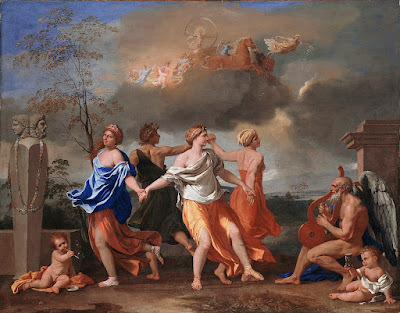 A Dance to the Music of Time by Nicolas Poussin
A Dance to the Music of Time by Nicolas Poussin A Dance to the Music of Time Series of 12 Novels by Anthony Powell C-
In my book grading system, a "C" is an average book. It is enjoyable, but not has nothing outstanding to recommend it over any other book. I usually do not finish books that would rate a "D" or "F" they just get "DNF". So, while I am not rating this series very highly, I did enjoy it enough to real all 12 books, which says something. And I should mention that the minus "-" it received was based solely on the last book, Hearing Secret Harmonies, which I did not enjoy at all. I think it "jumped the shark", so you can discount that "-" if you care to. However, given that the place and time period these books are set in is my favorite in history, this series of books had the potential to be an A+ series. The fact that it ended up a C- means that I will probably have a lot of rather negative things to say about it below. Just keep in mind that despite my criticisms, I enjoyed it enough to have read the entire series, and also keep in mind that I DNFed Lonesome Dove when McMurtry killed off Gus, after purchasing all four books and having read the two prequels, so that I have no problem not finishing a book I don't enjoy. Even if I paid money for it. With that out of the way, let's begin.
A Dance to the Music of Time, whatever it's literary aspirations may be, is a soap opera, pure and simple. The story involves a number entwined of families and characters woven together in an endless story. They grow up, start careers, fall in and out of love, get married, divorced, have affairs, advance, or experience setbacks in their careers, get rich, powerful, or not, in a closed loop, recounted in one long series of books, a series that could've continued on after the 12th book, even if I wouldn't have... It can be looked on as a R. F. Delderfield saga on steroids.
While I am not much of a lad for literary fiction, I have read books by British authors such as W Somerset Maugham, Compton Mackenzie, John Buchan, Nevil Shute, and Joseph Conrad, so that when I say that Anthony Powell's writing style is nondescript, even mundane, I say so in light of having read similar stories by some what similar British writers. His writing is wordy, thoughtful, and aspires to be literary. Heck there's passages of untranslated French and quotes from some classical literature in these books, so yah, he's a literary writer. Still, I found his writing serviceable, but unremarkable, his story telling pace slow, his scope limited.
I'm not a visual person, so that I don't expect to "see" a scene in my head like a movie, but the best writers, when they set out to create a scene, or a place, evoke a sense of that place and mood. By and large Powell fails to do that, at least for me. Oh, he takes the time to describe rooms in great and concrete detail, and as such does a competent job of painting a scene, but unless you are familiar with similar rooms, descriptions of furnishings can only do so much in creating a sense of the place. When it comes to London, he attempts to create a mood, a sense of place. I found these descriptions interesting. Having taken dozens of YouTube bus rides through London including the districts he describes, I came away with an appreciation of how much London has changed since the time he was describing them. Some of the rundown areas of the city he talks about are today's very trendy neighborhoods, and a house on Regent Park that he visits would be accessible only to millionaires these days. I guess that is the dance of time. However, once you get beyond rooms and London, his description of the countryside entirely failed to evoke any sense of place, time, mood. These descriptions often seemed to be meant more as symbols than actual places. And in general his failure to evoke the mood the historical times the story was set in was a major failing for me, since it applied to the entire time period this series covers. I hardly recognize England at any of them.
There was a British TV mini-series drama made from these novels. The people on the covers of the books I used to illustrate the series are drawn from this series. Now, if I was asked to filming this series, I would've filmed it in black and white, since the entire series of books seemed to me to be very grey in tone. Not quite noir, but in the entirety of 12 books there is not one scene of authentic joy. Every scene is told with a flat, reflective, semi-cynical eye towards the people and events. Dances and parties are attended, people gather for drinks or dinner, and if people are having fun, the narrator sees it all, people and events, as merely a guise. Life is grey, and if life has any bits of joy, happiness, and true laughter, they are not recorded by the narrator. To have filmed these books in black and white would've been faithful to the source material.
Talking about grey brings us around to the first person narrator, Jenkins. In a first person narrated story, the narrator is a character in the story. In these books Jenkins is hardly a character at all. He is mostly an observer, hardly ever an actor. We learn next to nothing about him. For example when he meets his wife, we are merely told that having done so, he knew from the start she was the girl he was going to marry and no more. He doesn't even describe her. Their marriage happens between books, and with the exception of a few scenes in the later books, she remains off camera, as does his children, his family life, his work. He makes some sort of living, first working for a publisher, then for a film studio, and later, I guess as a writer and a book reviewer, but all this is mentioned only in passing.
What he does is observe and ponder in long passages is what the other characters are thinking and why they are doing whatever it is they are doing. If these books were written in today's popular third person style with multiple point of view characters, the series would be half its length, and we, the reader, could've gotten to know the characters so much better, seeing their lives from their actual points of view. For the thing is, despite Jenkins' observations and pondering, we really don't get to know the characters very well. They remain opaque and vague. On one hand, do we ever know what people are truly like? But on the other hand, if pages and pages of speculation get you no closer to knowing... well what exactly is the point? One gets the impression that they are just objects upon which abstract observations about humans in general can be hung, rather than using these observations to craft true characters.
In any event, Powell uses this vagueness, the opaqueness, and the malleability he gives his characters to enable him to do whatever he wants with them. Indeed, I felt that the characters were always doing things that seemed to make no sense based on what we knew of them; things that seemed to be just for the convenience of the plot. Despite supposedly having a cast of 300 characters, he used and reused the core characters over and over again, regardless if, in my view, it made sense for that character to do whatever he had them doing. For example he has one extremely unpleasant female character who, for some reason, and I can only think for reasons of plot, everyone seems to fall in love with, including Winderpool who marries her, despite being the most unlikely character in the story for him to marry. Or, for that matter the most unlikely person for her to marry.
Speaking of Winderpool, he turns out to be the main character of the series, despite, or because, he is an altogether unpleasant character. No matter where Jenkins is, or what he is doing, you can always expect Winderpool to turn up, and you will never be disappointed. The whole series follows his story arch depicted in bits and pieces. There are, of course, many other characters as well, each described and pondered, but they come and go and come again, as needed across 12 books, only to fade away, die, or become a generic character, a mere name. Whatever their character was in the beginning long forgotten or blurred by age. They appeared in the later books just to dress the set as it were. The fact of the matter is, that with Jenkins being such a nonentity, there are no really memorable characters beyond Winderpool, in the 12 book series. He wins by default.
The blurb for this books says, in part, "It is unrivalled for its scope, its humour and the enormous pleasure it has given to generations." I found almost no humor in this book. Humor is a tricky thing, what some people find funny, others don't, so I can't say that the blurb lied, but I'll be damned if I could find anything more that a single remark, and some dialog by a character named Stringham that I felt were amusing. There is a scene where Winderpool, often the object of misfortune, gets a bowl of sugar poured on him at a dance by a girl. I assume this was meant to be a humorous incident, but Powell spends 7 plus pages setting up, describing, and pondering the incident... far too long and seriously for it to be funny. I have a feeling that the humor in these books, if there is any, and it wasn't just something a kind fellow book reviewer tossed into his review out of friendship, was the type that you had to be there, and know the people, to appreciate.
So did the books enrich my life in any way? Well, they passed the time and kept me interested in the dance of time. But I must confess that I'm not much of a lad for philosophy, so if there were nuggets of universal wisdom in the text, I overlooked them. Not being a regular reader of literary fiction, I probably wasn't the ideal audience for these books, so take that into your account when considering my opinions.
What is there left to say? The story was interesting enough to keep me reading, though I would've DNFed it after the last book if it hadn't ended there. However, I have to admit that I would not recommend it to anyone I know. Read W Somerset Maugham's The Razor's Edge instead.
November 1, 2023
The 500 Mile Long Parking Lot

Yes, I know, this parking lot doesn't look to be 500 miles long, and it isn't. Indeed, it looks longer in the photo than it really is. However, if you were to, let's just say, circle around it on your bike some 5,000 times, you would've traveled at least 500 miles. And gotten nowhere. A very zen thing to do. I speak from experience. I've put on 506 miles on my bike this season just by riding around this parking lot - like an obedient 7 year old whose mother told him that he could only ride his bike in the driveway. In many ways we get younger as we reach old age; more cautious, physically weaker, mentally less, shall we say, agile, not to mention those diaper things... So riding my bike around the parking lot is somewhat in character. That, at least, is my story.
However getting old is only part of the reason. The fact that it is the only flat surface on the hill we live on is my main reason for sticking with the parking lot. When I was a decade younger I used to spend two hours riding some 20 miles or more on my bike every day, spring, summer and fall, on a flat ex-railroad bike trail. Over the succeeding years I eventually cut that back to one 10 mile ride a day because my knees were aching by the end of the season. And then 4 years ago we moved to a new city and to the top of a hill. Between that hill and advancing age, I'm now down to a mere half an hour and 3 miles a day.
However, since 2010 when I purchased my Trek automatic 3 speed bike - a semi-dangerous solution looking for a problem - and the mountain bike I picked up at a yard sale several years later, I've put in some 26,700 miles on my bikes. And that doesn't include all the "miles" I've put on riding my bike on a rack these last half a dozen the winters, as the front wheel doesn't turn.
In any event, we live on the top of a hill and while one can ride around a small park and still stay more or less on the top of the hill, which I did for a year or so - one is still either going up or coasting down a slope, the going up of which wasn't doing my knees a favor.
Of course there is a wider world to ride than the top of our hill, but I have the feeling that either going up or down our hill would eventually kill me, though in different ways, so that's best avoided even with an electric bike. And while the city has plenty of bike trails and lanes, it's a hilly city so there wasn't many places to ride at my age without either an electric bike or tossing my bike into the van and taking it someplace to ride. Going someplace to ride is too much trouble and while buying an electric bike was something I considered, I realized that for what I ride my bike for, I didn't need to ride anywhere, so I didn't need it.
I ride a bike neither for exercise nor as a tourist, but for the zen experience of mindfulness, or in my case, for the opportunity to think of things - like the words I want to write - for more than 30 seconds at a time. It is a well known that doing something mindlessly repetitive, like walking, or in my case, riding a bike, is an aid to thought. Some of the most famous theoretical physicists were known to take long hikes in order to sorted out the quantum mysteries of the universe. I use the experience to string words together, over and over again until I can sit down and type them on the screen, like I'm doing now. And for that reason, I'm not concerned about the scenery. I knew the stretches of the bike trail I used to ride like the back of my hand after 15 years of walking and riding it. And though I'm no longer treated to the occasional sight of deer, foxes, turkey, geese other birds and all the wild flowers in season, that the bike trail through field and woods provided, I now get to talk to the neighbors when I'm out riding around the parking lot.
All in all, it is lucky for me I don't mind being seen as eccentric. I'm a writer and an artist, after all. As far as I'm concerned, being a zen bike rider is just another feather in my hat. Speaking of hats... well, we'll save that subject for another day.
Next week, the semi-annual report of my publishing company. Stay tuned.
 The parking lot on the last day of the biking season.
The parking lot on the last day of the biking season.October 28, 2023
The Saturday Morning Post (No. 19)

Here is the third installment of my review/thoughts on Anthony Powell's A Dance to the Music of Time, which I am treating as a novel in 12 parts rather than a 12 novel series. Rather than dragging this out, I am including the last two omnibus books, i.e. six installments in this review, and will give you my overall review next week.
My reviewer criteria. I like light, entertaining novels. I like smaller scale stories rather than epics. I like character focused novels featuring pleasant characters, with a minimum number of unpleasant ones. I greatly value clever and witty writing. I like first person, or close third person narratives. I dislike a lot of "head jumping" between POVs and flashbacks. I want a story, not a puzzle. While I am not opposed to violence, I dislike gore for the sake of gore. I find long and elaborate fight, action, and battle sequences tedious. Plot holes and things that happen for the convenience of the author annoy me. And I fear I'm a born critic in that I don't mind pointing out what I don't like in a story. However, I lay no claim to be the final arbitrator of style and taste, you need to decide for yourself what you like or dislike in a book.
Your opinions are always welcome. Comment below.
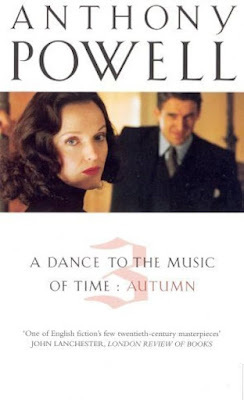
A Dance to the Music of Time; Autumn by Anthony Powell
The Valley of Bones (1964)
The Soldier's Art (1966)
The Military Philosophers (1968)
The Valley of Bones covers the first year or so of World War ll. Jenkin is now in the army as a second lieutenant commanding a platoon in a regiment that is stationed in Northern Ireland for training. We meet a mostly new cast of characters, the officers and enlisted men he works with. Most of the officers are not regular army, but civilians like Jenkins who had signed up at the beginning of the war. Some of them are old enough to have served in World War l, or been part of the Territorial Army, a part-time army like the American National Guard. Most of them, however, are finding their way in the army as they go along. For some it is a dream come true, others an escape from a less than successful life, and still others, a long grey nightmare. I found this installment with Jenkins in this entirely new situation more interesting than the usual dinner party/meeting format that characterizes the series. That said, it is still mostly concerned with Jenkins trying to decipher the character and motives of the people, new and old, that he meets in the course of the story.
The Soldier's Art gives Jenkins a new job while still in the regiment stationed in Northern Ireland. In this installment he is an aide to the now familiar, though unpleasant character, Windmerpool from his school days, who is a Major at the regimental HQ. We get some new characters, plus the appearance of another old school pal who shows up. A leave allows him to get to London and encounter yet more familiar characters. By the end of this installment, we are into 1941, with first months of the London Blitz behind us, but London is still experiencing raids nightly. As with all these books, the world outside of Jenkin's focus on people is hinted at with off handed mentions more than even sketched in.
In The Military Philosophers we find Jenkins now working in London working for an Army organization that liaisons with the remnants of the armies of defeated and overrun countries like Poland, the Belgium, etc. As in all these books, exactly nature of what Jenkins does, or for that matter, what the office he works for does is not really fleshed out in any great detail. There is a problem or two, and a trip to meet Field Marshall Montgomery (never named), and a glimpse of the war in London, but mostly the setting gives Powell an opportunity to introduce new characters for Jenkins to deal with, as well as bringing back old ones. This story takes us to the end of the war with Jenkins collecting the civilian clothes that British soldiers are issued at the end of their service.
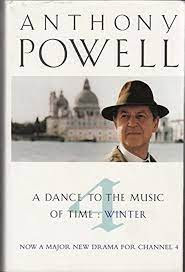
A Dance to the Music of Time; Winter by Anthony Powell
Books do Furnish a Room (1971)
Temporary Kings (1973)
Hearing Secret Harmonies (1975)
Books do Furnish a Room is set immediately after World War ll. Jenkins is working on a biography of one Robert Burton that brings him back to his old, unnamed university, and an old tutor. We meet some new and some old characters there, and he gets involvement with a new publishing house and a new magazine that involves a cast of characters from previous installments. While he is not directly involved in the venture, he is a contributing book reviewer. The main focus of this installment concerns a new character, Trapnel, a rather bohemian writer who writes pieces for the magazine and is working on a new novel. This aspect of the story struck me as something like W Somerset Maugham's The Moon and Sixpence, which followed the career of a painter. In our story Jenkin recounts the ups and downs of Trapnel, as he becomes involved with more familiar characters.
The next installment, Temporary Kings, is set a decade later, 1958 to 1959 and opens at a writers' conference in Venice. Here we meet several new characters, including a female college professor and a rather strange American professor who researching the now late Trapnel with a view of writing his biography as his dissertation. Along with these new characters, we meet the usual suspects and explore the various mysteries concerned with the tragic end of Trapnel and his mistress, and the implications of that end in regard to the usual suspects.
The long novel concludes with Hearing Secret Harmonies, once again skipping ahead a decade to be set in 1968 to 1971. In this one some of the characters from the last installment reemerge, as well as a charismatic hippy cult leader. The old characters are dying off and those that remain are so generic now that all that remains of whatever characteristics he described in earlier installments have been lost, at least to me. You would needed to have taken extensive notes to know who these people are and what they did in previous installments. I am going to save most of my thoughts about A Dance to the Music of Time to next week, but I will say here, that I really did not like this particular installment and felt that the book fell off rather sharply in Winter, which characters acting not as you would think they would, give their established characteristics, but as needed by the author, which is something I do not like at all.
But enough, stay tuned for my full review of the 12 book novel coming next week.
October 25, 2023
The Rosie Project Revisited
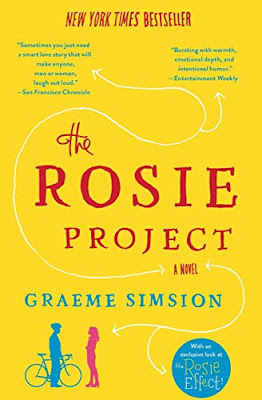
The Rosie Project is a humorous novel by Graeme Simsion that I read and reviewed back in August of this year, You can read my review, or a Wikipedia article to learn more about it. You can also sample it on Amazon or Google books.
The short synopsis is that the story concerns a brilliant Australian college professor who is on the Asperger's spectrum. He decides that he needs to be married. Being both socially awkward and detail orientated, he wants to find his wife in the most efficient way possible; through the various dating apps together with a 16 page survey to be filled out by the women who would like to date him. Needless to say, pickings are few.
However, due to a misunderstanding, he asks Rosie to a date under the false assumption that she is an applicant. Nevertheless, they hit it off... sort of, and their growing relationship is the basis of the story.
The book explores the mindset of a person on the Asperger's spectrum, but the author is not on that spectrum. However, a regular reader of mine, who has lived that life, read my review, searched out, found and read the book. He recently emailed me his reactions to the book. I thought that they were entertaining, interesting as well as educational, so I asked him if he would be willing to share his reactions with my blog readers. He has kindly allowed me to publish his remarks - Thank you.
So what we have below is his thoughts inspired by certain passages in the book. The passages he quoted from the book are in bold italics with our guest blogger’s reaction to them below.
Our contributor's observations on The Rosie Project begin with a few general comments on the book and his experiences and then are reactions to specific quotes from the book to further illustrate his points.
The Rosie Project (Simsion,Graeme) The "Rosie Project" is a quite interesting novel,the style is intriguing and funny. I did not like the last part ofit. Seems a lot of books of this type end in marriage as the highestpurpose in life. It's boring. I started reading the sequel, "TheRosie Effect" but this was a horror. It started where the"Project" ended and I was not able nor willing to continuereading that one. Okay, if readers want babies and mothers the authorgives it to them but it's still boring. A few funny dialogues doesn’thelp.
Concerningthe Asperger Syndrome, what the author has written is correct, butnot comprehensive. First and foremost Aspergers are sensitive againstinfluences, like flickering fluorescent tubes, noises or evenemotions of other people. I can't work in a room with amalfunctioning tube, let aside with some employee running radiomusic, and I asked a friend of mine not to use sad emoticons in here-mails because they cause me depression. I can't stand seeing how adog or a child is mistreated, I feel forced to intervene. The resultmight be one of the following.
Overload, Over-stimulation. Everythingsuddenly is experienced by the person at 100 percent. Noises are asif a bomb explodes, lights cause extreme effects, problems includingemotions of other persons can not be kept separate from their ownemotions.
Shutdown. The person is unable to act or react. I watcheda cashier who was confronted with a problem she could not solve. Shejust sat there for minutes, not able to speak.
Meltdown, panic, atotal loss of control, experienced as fight for life. The subjectdoes not feel pain nor understands that he might cause pain anddanger to others, risk his own life or might be punished.
So, I thinkthe author might have observed persons in the autistic spectrum buthas no profound knowledge about Aspergers Syndrome nor is he onehimself.
"Mostdiseases have some basis in our DNA, though in many cases we have yetto discover it."
TheAsperger Syndrome and being part of the Autistic Spectrum is nodisease. I believe that it was important for the human race that atiny part of them think differently and act differently, e.g. livealone in a hut in the woods and detect how to make fire. As ananalogy, scientists have found out that the survival of a stone agetribe might be promoted if some, but not all women live until theyare grandmothers, helping to raise the children and providing soundadvice from their experience.
"brainfunction that had been inappropriately medicalized"
Youcan't medicalize autism. You might apply drugs which have a sedatingeffect. You must educate the non-autistic part of the people totolerate autism, e.g. that autists are missing the instinctivebehaviour to make eye contact and that this is not a sign that theyare lying.
"Nowwe would have the inevitable small talk. I could have spent fifteenminutes at home practicing aikido."
Nowthat's a calculation I, being myself in the autistic spectrum, makeall the time.
"offeringpractical advice, but it seemed that she preferred to discuss trivia"
Yep.I often teased my partner she should make notes when I explainsomething to her. I am not able to discuss trivia.
"Itseems hardly possible to analyze such a complex situation involvingdeceit and supposition of another person’s emotional response, andthen prepare your own plausible lie"
Correct.I don't lie unless it's necessary for a good joke. It takes too muchtime and effort.
"Icontinued with my presentation as I had prepared it."
Correct.I take much trouble to plan and prepare an activity, e.g. a tour withmy bike club. Sometimes I had arguments with my group if suddenly themajority of them voted for changing the plan. Too much depended on myplans, e.g. to take a route where the sun would not shine from thefront directly into my eyes.
"Asperger’sisn’t a fault. It’s a variant. It’s potentially a majoradvantage"
Maybean advantage for mankind - some think that Einstein, whose strengthis said to think things which are inconceivable for other people, wasan Asperger. But the individual lacks the support of all other peopleand often is considered crazy and stupid.
"sheput her hand on my shoulder. I flinched automatically. "
That'snormal.
"Noflexibility?” “Definitely not"
Thisis definitely a disadvantage of being an Asperger.
"BeforeI met Gene and Claudia I had two other friends"
Okay,I am a senior so most friends and all relatives in my life havepassed away anyway. But today I have four friends which I communicatevia whatsapp, messenger or email. In the average I may see them twotimes per year.
"Shetold me that her birthday had always been her favorite day of theyear. I understood that this view was common in children, owing tothe gifts, but had not expected it in an adult"
Idon't celebrate my birthdays. Why celebrate when my remaininglifetime just has been reduced by one year.
"Mostadults with Asperger’s syndrome don’t know they have it"
Igot my diagnosis at 62 years.
"thehoroscope readers", "the sports watchers, thecreationists", "the homeopaths"
Idon't understand them. I am personally suffering to be locked withall of them on the same planet. I only can bear them when I rememberI might be responsible for them, e.g. my coworkers while I am betweenthe CEO and them.
"acceleratedworkout at the gym, achieved by deleting the shower", "AlthoughI was perspiring heavily from the heat and exercise"
Whybother with showering daily if I don't meet people anyway. When I wasa child, everybody bathed on Saturdays.
"Thecorrect answer is (c) on time,” I said. “Habitual earliness iscumulatively a major waste of time"
Can't stand people whocome early to an appointment. If I expect somebody for 4 hours P.M.,I need my time for preparations, to have ready fresh made coffee by3:50 and finished setting the table by 3:59.
"Howoften do you train?”
“Three times per week"
At50, I started training karate four times a week. Not because I wantedto become a superman, but because for Aspergers it is extremelydifficult to learn new, rhythmic movements, e.g. dancing, or karatekatas.
"Ihad not been to an art gallery since the tenth of May, three yearsbefore"
(Grin)That could be me, telling somebody else or composing an entry in myweblog which my few friends have the password of. Yesterday's entrywas: " Kl. Rasenmäher: Messer und Haube abgeschraubt, Grasresteim Motor ausgeblasen und die Luftfilter gereinigt sowie mitHeißklebepunkten wieder eingefügt, den dicken Grasfilz mitzurechtgeschnitzten Hölzchen abgekratzt. Das Messer hatte ichzuletzt am 14.1.23 geschliffen, davor am 19. April 21."Translation (short): "Cleaned the small lawn mower, removedsickle bar and hood, cleaned motor and filters. Last time I sharpenedthe cutter bar was on 14 January, 2023 and before that on 19. April,2021".
"Iput the herb and vegetable mixture in the large saucepan with thewater, salt, rice wine vinegar, mirin, orange peel, and corianderseeds."
Myblog entry from yesterday: "Abends zwei Hähnchenflügel, 20minbei Höchsteinstellung 230 Grad, 5min auf dem Gußgrill, weitere 5mindrauf belassen". Translation: In the evening I had two chickenwings, 20min at the maximum of 230 degrees Celsius, 5min on the castiron electric grill, stayed on it another 5min".
"Rosiecould leave and life would return to normal"
Correct.I like to have a visitor. Then I am glad if he/she's left and I canreturn to my routines and planed tasks.
"Iwent to the whiteboard and started writing up revised preparations"
Yeah,I have plans for everything, daily, week, months, life.
"“Well,”she said, “it’s been an evening. Have a good life.”
Itwas a nonstandard way of saying good night. I thought it safer tostick with convention. “Good night." I never know what I amexpected to say.
"Itold him that the flavor didn’t matter, as long as it containedalcohol."
That'smy standard line, meant as a joke or to shock people I can't stand.
"beingreminded that I needed to try harder to “fit in"
That'swhat I was told all my life. "Fit in with the onward surge ofthe lemmings, which inevitably ends in disaster".
"shehardly spoke at all. This made the walk quite pleasant"
Ionce met a girl with whom I made a trip to a beautiful lake and wewatched, smiling, a nutria who had no idea we were there. She hardlyspoke at all. She then was my partner for decades and still is mybest friend.
"hewas large and angry. In order to prevent further violence, I wasforced to sit on him".
Sofunny!
"Iam not naturally a dexterous person"
Aspergersnever are. That is the reason for: "considerable practice over along period"
"Idiagnosed brain overload and set up a spreadsheet to analyze thesituation."
WhenI told a psychiatrist exactly the same thing and showed her a 30 yearold spreadsheet, she immediately diagnosed me with Asperger Syndrome.
"Lookat me when I’m talking"
Aspergerscan't do that. In the moment where they forget strict to controltheir viewing direction they won't look at the other person.
"mydefault assumption is that people will be honest"
Yeah,that was the big problem in my life. I never thought so lowly likesome other people. Once I voluntarily maintained a public areabordering at my property. A neighbour asked me what I am doing,adding public property to my own. I never knew that the idea, tosteal a little bit of land, existed on earth. Another time, I paid myfood in a snack bar and took it to my table. Then I was admonishednot to steal the salt shaker. I did not know that there might bepeople thinking so lowly and are so stupid to believe that somebodywould steal a salt shake worth 1 Dollar. I never went to that placeagain. The are not really my race there, they only look like me.
"Withthe repeat button on", "Unlike many people, I am verycomfortable with repetition"
Ofcourse. If I like a piece of music, why not have it on repeat forsome hours or days.
"Onesentence per day. Leave out eating, sleeping, and travel.” Thatmade it easy. “Sunday, Museum of Natural History; Monday, Museum ofNatural History; Tuesday, Museum of Natural History; Wednesday—”“Stop, wait! Don’t tell me Wednesday. Keep it as a surprise."
SOFUNNY
"Howlong have you had that shirt?”
“Fourteen years"
Iam quite experienced with turning the collar right side out after afew years so the shirt looks like new again. Have the best sewingmachine you can buy for money (Bernina).
" never watch sports. Ever. "
Ido sport. I do not sit in an armchair and watch other people doingsports. That doesn't help for better health and there is no excitingcombat like, for example, in participating in a basketball game.
October 21, 2023
The Saturday Morning Post (No.18)

Here is the second installment of my review/thoughts on Anthony Powell's A Dance to the Music of Time, which I am treating as a novel in 12 parts rather than a 12 novel series. I am going to be a bit briefer in these reviews, saving most of my more general thoughts to when I'm finished reading them, wherever that turns out to be.
My reviewer criteria. I like light, entertaining novels. I like smaller scale stories rather than epics. I like character focused novels featuring pleasant characters, with a minimum number of unpleasant ones. I greatly value clever and witty writing. I like first person, or close third person narratives. I dislike a lot of "head jumping" between POVs and flashbacks. I want a story, not a puzzle. While I am not opposed to violence, I dislike gore for the sake of gore. I find long and elaborate fight, action, and battle sequences tedious. Plot holes and things that happen for the convenience of the author annoy me. And I fear I'm a born critic in that I don't mind pointing out what I don't like in a story. However, I lay no claim to be the final arbitrator of style and taste, you need to decide for yourself what you like or dislike in a book.
Your opinions are always welcome. Comment below.
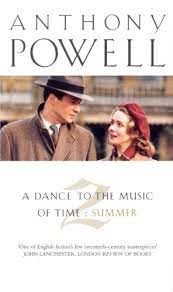
A Dance to the Music of Time: Summer by Anthony Powell
At Lady Molly's (1957)
Casanova's Chinese Restaurant (1960)
The Kindly Ones (1962)
These novels can be described as a series of encounters described in great detail with established and new characters over the course of decades. If you are interested in who these characters are based on, there is a web site here that lists them along with photos from real life and the TV series, I believe. The website is also a resource for all things A Dance to the Music of Time and Powell.
At the start of At Lady Molly's Jenkins is working writing scenarios for the film studio. Starting in 1927 a certain number of films, initially 7.5% raised to 20% in 1935, that were shown in Britain had to be made in Britain or its Empire. They usually where the second film on the program, and many of them were made quickly and cheaply just to fulfill the requirement. In any event, a friend from the studio takes Jenkin to Lady Molly's house where people seemingly gather every night to socialize. Here he meets several new or previously minor characters, as well as one or two of the usual suspects. From this first gathering flows several more extended encounters with various people connected one way or another with that night.
His affair with the married woman is over at the start of this installment, and by the end of it, he has encountered the woman who I believe is related to Molly that he is going to marry - knowing so at first sight. She is one of the youngest of a large family which he knows at least some of the members. There is a tangle of inter-family relationships throughout this series, a tangle that I can't hope to untangle, and don't bother trying. As I said in the previous post, I just go with the flow.
With Casanova's Chinese Restaurant, we start with a rather confusing back track in time in order to introduce some new characters; a composer, Moreland, and his musical friends before taking up the story some time after At Lady Molly's. Jenkins is now married and his wife is recovering from a miscarriage. Once again the story consists of several gettogethers this time with his musical friends, a party or two, and an introduction to his various eccentric in-laws. We're now in the late 1930's with the civil war in Spain going on. Every once in a while one of his old schoolmates shows up, including Wnderpool, usually rather disastrously. As it has become the pattern with these stories, much of the action is describing various gatherings, large and small in exhaustive detail, with much musing on the characters, old and new that he meets at these gatherings.
We take another trip back in time at the start of The Kindly Ones, this time back to his childhood in 1914. His father is an army officer and they are living in a "haunted" rented bungalow near Aldershot where is his father is stationed. We are introduced to the various servants and their various idiocentric behaviors, This chapter comes to a head when, while entertaining the Cello playing General Conyers and his wife, who we've meet previously, and waiting for the unwelcomed arrival of Uncle Giles, one of the servants, who having seen a ghost that night, has a nervous breakdown. Uncle Giles brings the news of the assassination of the Archduke Ferdinand sparking the first world war.
We then skip ahead twenty five years to the waning days of peace before the start of World War ll, and a gathering once more featuring the composer Moreland who he backtracked to introduce in Casanova's Chinese Restaurant. And once again we have a series of meetings of various sorts with old and a few new characters, with the story ending at the beginning of World War ll and Jenkins, the narrator looking to get into the army.
I realize that I am being rather uninformative in these reviews, in part because of the nature of these stories; not much happens beyond the house parties Jenkins, our narrator, attends, plus a whole lot of reflection on the lives of the people he meets at these affairs. The fact that Jenkins says next to nothing about his life, I think detracts from these stories, since all you are left with this rotating cast of characters, never on screen for all that long at any one time.
More next week.
October 18, 2023
Writing Season
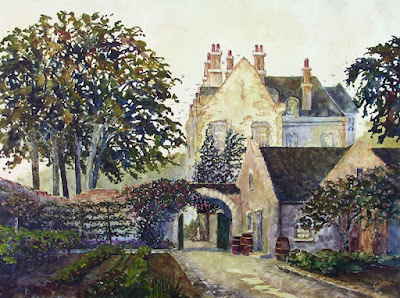
Well, the leaves are turning and writing season is upon us. I took the spring and summer off from writing fiction. When it's warm enough to be outside, I want to be outside, not inside at my desk. Oh, I maintained my habit of writing by spending an hour or so every morning writing my two blog posts a week, so with that habit still intact, it will be simply a matter of switching over to writing fiction and spending a bit more time writing... Once I have a fiction story completed in my head to write.
I'm working on that, having spent the idle spring and summer daydreaming a potential new story. I have a setting, a situation, named characters, and even five pages of notes to remind me of what I had dreamed up with, though they will be largely obsolete if and when I start writing, since the details of the story change week to week, day to day. But even with months of thinking about the story, I haven't been able to organize my many little scenes and ideas into something resembling an actual story. And to be honest, I'm far from certain that I will be able to. Nor have all the characters really come into or stay in focus. And while you don't have to know everything before you start writing, and indeed, some writers know next to nothing about the story when starting, past experience has taught me that I need to know not only the beginning, and the end, but the middle as well. And to be honest, at this point, I don't even have the end clearly in mind.
The fact is that this time around, I'm determined to have a complete story, one with a beginning, a middle, and an end solidly in mind before I start setting it to words on a screen. In the recent past, when I reached the middle of the story I thought I knew, I discovered that I had merely done a lot hand waving over the middle of it, content with only vague ideas about what to do when I got there. They proved so vague that I couldn't put words to them, forcing me to stop and work something out in greater detail, breaking the flow of writing. This time I'm determined to have the entire plot in my head; indeed, I might even write a bullet point outline down before I start so I can write straight through the story without getting lost in the middle. However, with summer of daydreaming, the fact that I've not built that complete story in my mind suggest that this story may not end up going anywhere. Always a very real possibility.
As for the story that I do have in mind, it would be released a straight "Fiction/Literature" category story, though with no pretense to being literary fiction. This time around I'm deliberately not aiming at any specific genre, even though it will have elements of fantasy/science fiction, mystery, and romance in it. Indeed, it will be step further away from genre writing than the Girl on the Kerb.
I'm thinking that the story will reflect the types of stories I've been reading and enjoying recently; that is to say small, slice of life stories where things happen, but there is no strong, over arching story line, i.e. no Hero's Journey or epic quest. It will probably have a mystery for an underlying driving force. And while the story is set, in my mind, in my usual "universe", on a planet settled by Homo Stellar humans with their 200 year life spans. That event is in the distant past, suppressed and distorted into myth. The setting will be my usual Edwardian era type with a mix of old and new technology.
The working title of this piece is Chateau Claire and the premise is that our narrator finds that he is the heir of a once important family he never knew he was related to. With the death of an unknown great aunt, he comes into the possession of the the title chateau on Summer Isle. The story will recount the changes his life that ensue from this event, as well as a mystery surrounding this great aunt. At present I've played out lots of little incidents in my mind, come up with lots of ideas for plot points at the beginning, but things peter out after that. I haven't been able to bring them all together into a cohesive story that would keep readers reading it. I expect I'll keep working on this story until the end of the year, but since it takes me three to four months to write the first draft of a novel, and several more to revise it, I will need to start writing it by the new year for it to be my 2024 novel. At the moment it is very much a bird in a bush. If I don't have it in hand by then, it's on to plan B.
Plan B is to return to and finish writing A Passage to Japara. That story, currently at 45K written is half or more done. It is currently aground on the reef of two major scenes that I've yet to invent original enough details for to make them worth writing. I have to believe that, if motivated enough, I could come up with those scenes, and get the damn story afloat, written and done with. However, at the moment it is Chateau Claire that holds my interest, though I have a feeling Passage to Jarpara has the best chance of being released in 2024. Who knows? It could be neither. I'm not under contract, so I don't have to write anything.
Stay tuned.
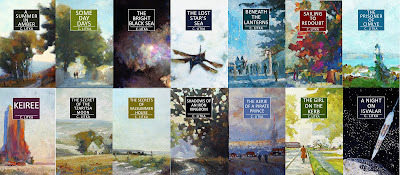
October 14, 2023
The Saturday Morning Post (No. 17)

Well, with the Blandings Castle saga behind me, I have decided to embark on yet another saga, this one quite different. It is, however, also set in England and it covers the period from 1921 to the 1960's. I'm talking about Anthony Powell's A Dance to the Music of Time series of twelve novels, or a novel in twelve parts. The twelve books in the series are often divided into four "seasons" of three books each. These three book omnibuses are how I purchased the books - and yes, not having learned my lesson with the Lonesome Dove saga, I purchased the entire series from Abe Books in one go.
The blurb says that the "...sequence chronicles the lives of over three hundred characters and is a unique evocation of life in twentieth century England. It is unrivalled for its scope, its humour and the enormous pleasure it has given to generations." As someone who finds Britain in the first half of the last century as my favorite place and time, this sounded like a series right up my alley. I came across it in the Axillary Memory blog of James Wallace Harris, and you can read his far more thoughtful reviews of the books; here, here, and here.
In this installment I will talk about the first three novels/installments of the series A Dance to to the Music of Time: Spring. that I have read to date. I will keep any insights gained from reading further books to when I read them, or the final entry, however far I get. Thus, what you read here is only how I viewed the work after reading Spring. My impressions may change as I go along.
My reviewer criteria. I like light, entertaining novels. I like smaller scale stories rather than epics. I like character focused novels featuring pleasant characters, with a minimum number of unpleasant ones. I greatly value clever and witty writing. I like first person, or close third person narratives. I dislike a lot of "head jumping" between POVs and flashbacks. I want a story, not a puzzle. While I am not opposed to violence, I dislike gore for the sake of gore. I find long and elaborate fight, action, and battle sequences tedious. Plot holes and things that happen for the convenience of the author annoy me. And I fear I'm a born critic in that I don't mind pointing out what I don't like in a story. However, I lay no claim to be the final arbitrator of style and taste, you need to decide for yourself what you like or dislike in a book.
Your opinions are always welcome. Comment below.
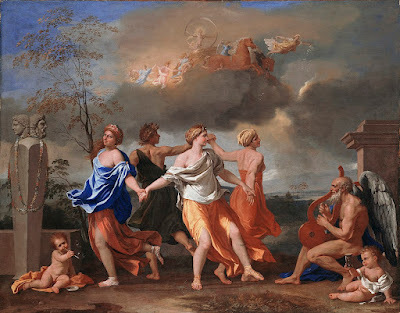 A Dance to the Music of Time by Nicolas Poussin
A Dance to the Music of Time by Nicolas Poussin First some notes on how I'm approaching this project.
I will treat this as one novel in 12 parts. Having read the first three novels, I think that each "novel" does not stand on its own very well, and since reading them in order is essential, as characters introduced in the first book, appear and reappear throughout the stories, Without their context from the previous books, their situations would not make a great deal of sense. And since I am treating this as a single novel, I will grade it only after I have read all of the books, or when I stop reading them, whichever comes first.
I'm reviewing these novels in sets of three, as published in the omnibus versions I purchased. They are designated by the four seasons, and each three novel set seems to cover a decade or so. I am going to treat each of the three "novels" as installments in the 12 part novel. I don't know how many installments I will read back to back without a break. We'll find out.
The stories seem to be semi-autobiographical. Semi in that from what I've read about the author in Wikipedia, the first three stories somewhat reflect the course of the author's life. I suspect that he took people and incidents from his life to use and manipulate to create this work of fiction. For example, while the author went to Eton, the narrator of these stories, Nicholas Jenkins, certainly did not. That said, both went to university, (unnamed in the book) and both worked for a publisher of art books, and both wrote a novel while doing so. So yes, there are parallels, ones that we might explore later on.
The concept of the story is inspired by the painting above. It is a work by Nicolas Poussin entitled A Dance to the Music of Time, painted around 1634-36 The idea is that just as the dancers begin to dance in a circle, and then, one by one each leaves the circle to dance alone before returning to the circle, so do the people one knows, entering and leaving one's life off and on throughout it. There is no doubt a lot more symbolism in the painting, and certainly in the books, but I have a feeling that most of that goes over my poor head.
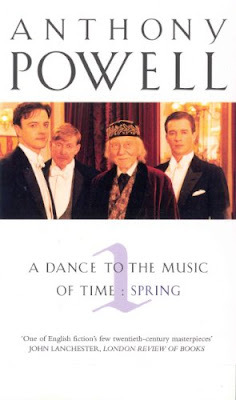 A Dance to the Music of Time: Spring by Anthony PowellThis volume includes:A Question of Upbringing (1951)A Buyer's Market (1952)The Acceptance World (1955)
A Dance to the Music of Time: Spring by Anthony PowellThis volume includes:A Question of Upbringing (1951)A Buyer's Market (1952)The Acceptance World (1955)These three books or installments cover the time period from about 1921 to 1930 - the final installment mentions the "slump" which I take to be the stock market crash of 1929 in the States. They cover this period like a stone skipped over a still pond; each book is divided into 4 or 5 chapters, each concerns on a certain narrowly focused incident or situation - a dance or a dinner party. Months, if not years, separate the events described within each book, with the intervening period mentioned only in passing. Thus, we are treated to a series of snapshots, rather than any sort of narrative of Britain of the time.
A Question of Upbringing begins with the narrator, Jenkins, in an unnamed boarding school where we are introduced to a cast of fellow students, and other characters who will reappear regularly through the following years. After school he is sent to France to live in a boarding house to learn French, then attends university.
In Buyer's Market and The Acceptance World we find that he has moved to London and is working for a publishing company that publishes art books. By the end of this set, he has published his first novel, though it is mentioned only in passing, and is carrying on an affair with the separated wife of someone who he once met briefly. As I mentioned above, these snapshots which comprise the format of the novel usually cover a single episode in his life and their immediate ramifications. We are treated to a view of life in British upper society, though as the son of an army officer, Jenkins' status is rather undefined. Apparently he comes from a family good enough to be invited to the dances of the upper class. We also get glimpses of the artsy society and left wing political activity. As an eligible bachelor he is is invited to the dinners and balls of "The Season" where the daughters of the rich are formally introduce to society to begin their quest for a suitable husband. Along the way we are introduced to many more reoccurring characters from different parts of his life. If, like my wife, you are need to take notes to keep the characters straight in a mystery story, you might want to have a notebook handy when reading these stories, as they are claimed to have a cast of 300 characters. I just go with the flow, the main characters are on stage often enough, and the side characters, are, well, side characters.
As for Powell's writing style, a passage more or less at random will illustrate it: "That illusion, such as a point of view was, in due course, to appear - was closely related to another belief: that existence fans out indefinitely into new areas of experience, and that almost every additional acquaintance offers some supplementary world with its own hazards and enchantments. As time goes on, of course, these supposedly different worlds, in fact, draw closer, if not to each other, then to some pattern common to all; so that, at last diversity between them, if in truth existent, seems to be almost imperceptible except in a few crude and exterior ways: unthinkable, as formerly appeared, any singe consideration of cause and effect."
In short, this is literary fiction. While my selection might have been chosen for its meandering depths, much of the writing is along the same lines; wordy and thoughtful. No doubt there is a lot of food for thought in these stories, if you care to invest in the time to extract it, though I must confess that my eyes rather glaze over upon coming on passages like this, content to merely get the gist of it. If that. Que sera, sera.
Because this is a first person narrative, Jenkins spends a lot to ink pondering what is going on in all other characters' minds, and in their lives, throughout the story. Indeed the major focus of the stories is speculation on what other people are thinking, why they are doing what they are doing, and what they hope to accomplish, as he encounters them off and on over the years. I will say that the third novel, written several years after the first two, moves at a somewhat brisker pace than the first two, and I have hopes that future installments will have a bit less naval gazing and more dialogue in them.
My initial hope with these books was to get a sense of Britain in this time period, and I suppose I am; a sliver of it from a certain class of people. Even so, it is interesting enough. My biggest complaint so far is that there has not been one glimpse of joy in the stories he choses to tell, and not a lot of humor, that I can detect, anyway, so far. However, we have only begun and anything can happen as it goes along.
A small point; in one of the episodes, Jenkins, after attending a ball, runs into an artist friend and his girl helper late at night, and he is invited to join them to get a cup of coffee at "the stall by Hyde Park Corner," where they meet another friend of Jenkins. Many years ago I painted that very stall by Hyde Park Corner, base on a photo in the book, The Spirit of London by Paul Cohen-Portheim (photo #101 2 A.M. At Hyde Park Corner.) I have reproduced my ink painting below.
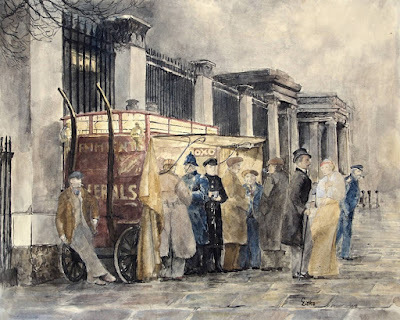
Coming up next week: A Dance to the Music of Time: Summer
October 11, 2023
The Girl on the Kerb Experiment
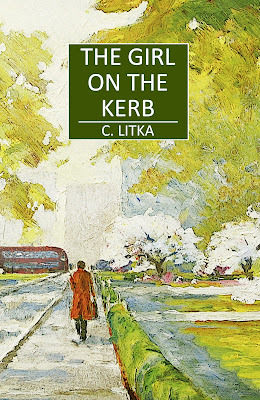
Six months ago I released my 2023 novel, The Girl on the Kerb. Until this book all my books had been released as either science fiction or fantasy. I used SF mostly as a setting for the story. By doing so, it allowed me the ability to write the story I wanted, as I wanted it, without somehow shoehorning it into a known time and place. Even though my stories were set in the future, many of the settings I chose to use have been reminiscent of life in the first half of the 1900's. I seem partial to that historical period, perhaps having read a lot of stories set in that time period. The Girl on the Kerb was no exception. Though set in the far distant future, the society was reminiscent of the 1930's, with radio, newspapers, trains and cars, but no cell phones, internet, and personal computers. This being the case, I decided to release the book based not on its setting in the far future, i.e. as SF, but on the major plot element of the story, which is to say, as an espionage novel.
There were both pluses and minuses in doing this. Let's look at them.
On the plus side, I was pretty sure that my regular readers would find the book no matter what category I released it in, so that I did not expect to lose many, if any, regular fans. On the other hand, by releasing the book in a new genre, I could potentially reach new readers. And some of these readers might go on to read more of my other books.
In the minus column there were several points to consider related to these potential new readers. Espionage is not a standalone classification. It falls under the "Thriller" classification, i.e. Thriller/espionage, and Thriller/adventure. I hadn't written a thriller in The Girl on the Kerb unless there is a "cozy thriller" sub-genre. This meant that hardcore thriller readers were not going to find many of the things they usually look for in a thriller; violence, guns, death, sex, and high stakes. In addition they would be on unfamiliar ground, since the story was not set the familiar modern world but in the future. The question was/is how would they react to these twists in the genre? There seemed a good chance that I could annoy at least some of the regular readers of the genre and risk being hit with low ratings as a result. I decided to take that risk.
So how has it gone, after six months?
First off, it enjoyed some very unexpected sales. I can't definitely assign this result to releasing it as an espionage novel, it is probably serendipitous, but I never sold so many books in the first month as I did with The Girl on the Kerb. I released it as I usually do; free everywhere except on Amazon, where I priced it at $3.99. I had the ebook up on preorder for a month, and sold 17 copies at that price in the first week, which was very good for a book of mine. However, within a week Amazon caught wind of the free price elsewhere and decided to match the free price. This was fine with me. I used to let them know about my free prices elsewhere just to get them to do that, but I don't bother any more. Anyway, the switch to free resulted in the sale of several hundred books in a couple of days, which, in turn, seems to have caught the attention of Amazon's promotional algorisms and they must have promoted it somewhere, somehow. It ended up selling 2,610 free copies on Amazon in April. Sales tapered off after that, of course, with monthly sales of 165, 193, 76, 108, only to spike again in September with 864 free copies and 2 at full price (i.e. non-US sales). Which means that in its first six months, I've sold a total of 4,035 copies on Amazon and the book has remained on the upper half of Amazons top 100 free thrillers in its categories ever since release. All told, I've sold over 4,600 copies to date. My usual releases may sell around 1,000 in their first year, at best. Did this have anything to do with its release category? Somehow, someway, I think it does, but I can't prove it.
So then, have all those sales led to an increase the sales of my other books?
Just eyeballing my sales on Amazon in the months prior to April and afterwards, I would say no, they stayed pretty much in the range they had been prior to the book's release. However, since ratings are only now coming in at an increased rate, any effect on the sales of my other books may still be a ways in the future. We'll see.
As to my fears, how did thriller readers react to the The Girl on the Kerb?
First off, perhaps due to the number of sales, it has received far more ratings in the first six months than any other book of mine. It has about 80 rating at this point, all told, but only three reviews, with only one on Amazon. Currently its star rating is 4, plus or minus a decimal point depending on the source. While I can't complain, it is a tad lower than my usual books. The lower rating is due to it having 5 or 6 one star ratings, as well as a similar number of 2 star ratings, which are significantly more than what my books usually garner, especially in the first six months. Plus, its 5 star ratings are less than the 50% level that I would like to see. Of course there is the "and/or" possibility that the book simply isn't as good as my other stories, but that is something that I can't say one way or the other. Still, I'm thinking that I did annoy some readers and that the lower score is a result of some pushback from regular thriller readers. You have to take the rough with the smooth.
Will I do it again?
Yes. Any book I write in the future (birds in the bush) that is not connected to any of my published SF titles will not be sold as SF, even though they will also be set in the future and likely on another world, as usual. One small reason for this is because I'm so over SF. I'm no longer count myself a SF fan. However, given the results of The Girl on the Kerb, I see no reason not to categorize the story by story type rather than setting, and I think that I have a good reason for doing so with any future book. Trying new things in publishing is almost a requirement, unless you're minting money. I'm not.
So what might be my next non-SF book? Stay tuned for a glimpse of that bird in the bush next week.
